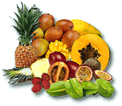September 2005
The Daley News
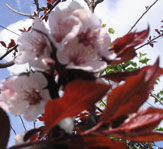 Spring is that delightful time of regeneration and rebirth in the year - when the fruit blossoms are out and we are eagerly anticipating the delicious fruits to follow in summer.
Spring is that delightful time of regeneration and rebirth in the year - when the fruit blossoms are out and we are eagerly anticipating the delicious fruits to follow in summer.
It is also a very busy and productive time in gardens and orchards, with lots to do to ensure bumper crops in the following months. Now is the time to fertilize mulch and give your trees a deep watering with a little extra seaweed to condition the soil.
In subtropical Northern NSW, we are in the middle of our dry season, so it is very important for the health of your trees to keep up good moisture levels in the soil. This is best achieved with a weekly deep watering treatment. Only giving your trees a little water encourages the roots to grow near the surface, resulting in a less drought-hardy tree that is not so stable in the ground.
For deep watering, it is vital to remove all weeds and competing plants, especially grass from around your trees. I do this by hand; I lightly lift the weeds with a fork being very careful not to disturb the roots, especially with citrus trees that are shallow rooted, then I hand pull the weeds. Once the weeds have been removed, fertilize your tree with your chosen fertilizer. I use a hearty amount of compost mixed with rotted manure and a handful of slow release fertilizer, a good NPK fertilizer is all that is required. Water deeply with liquid seaweed and apply a generous layer of 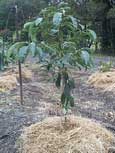 mulch.
mulch.
My preferred mulch is Lucerne hay, but any organic mulch will help improve the micro flora of your soil as it breaks down. Cardboard and newspaper can be laid beneath the mulch to retain moisture and suppress weeds, however make sure the soil is moist before laying it as it also prevents the rain from entering unless it is very wet. It is important to keep this mulch away from the stem of the tree to avoid collar rot. If you have acid soils, a couple of generous handfuls of dolomite will sweeten your soils.
Another job that is important to do in the orchard at this time of the year is thinning your stone fruits. By knocking out the excess buds, you will get a bumper crop of 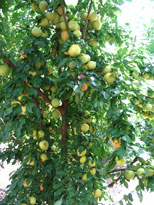 delicious large fruits, if you leave all the buds to form fruit you will have a tree with lots of small fruits that do not have enough room to develop. If you are going to net your trees it is also the perfect time to check the net for holes, mend it if necessary and set up a structure to stretch it over. It is important when netting fruit trees to stretch the net tight to prevent birds and bats from being tangled in the net. As I mention last month we have been working hard on our web site and I take great pleasure in introducing Correy, who is the person responsible for all the wonderful new additions to the site.
delicious large fruits, if you leave all the buds to form fruit you will have a tree with lots of small fruits that do not have enough room to develop. If you are going to net your trees it is also the perfect time to check the net for holes, mend it if necessary and set up a structure to stretch it over. It is important when netting fruit trees to stretch the net tight to prevent birds and bats from being tangled in the net. As I mention last month we have been working hard on our web site and I take great pleasure in introducing Correy, who is the person responsible for all the wonderful new additions to the site.
 My name is Correy and as one of the Daley's Nephews I have enjoyed tasting the different fruit varieties from the orchards and seeing the nursery change over the years. Actually the Nursery was started in the year I was born 1980. With the website getting more popular I was invited by the uncles to make some exciting new changes, so if you have time make sure you check them out and tell us what you think. The most notable change is the shopping cart which now lets you know approximately how many of each plant we have in stock. Also if that special fruit tree your after is not in stock we give you the option to enter your email address and be the first to know when it's ready to be sold. We have also made it quicker for our staff to process these orders, so the moment you press finalise order our staff can get straight to picking your order. Thanks to all who have given feedback on these new changes.
My name is Correy and as one of the Daley's Nephews I have enjoyed tasting the different fruit varieties from the orchards and seeing the nursery change over the years. Actually the Nursery was started in the year I was born 1980. With the website getting more popular I was invited by the uncles to make some exciting new changes, so if you have time make sure you check them out and tell us what you think. The most notable change is the shopping cart which now lets you know approximately how many of each plant we have in stock. Also if that special fruit tree your after is not in stock we give you the option to enter your email address and be the first to know when it's ready to be sold. We have also made it quicker for our staff to process these orders, so the moment you press finalise order our staff can get straight to picking your order. Thanks to all who have given feedback on these new changes.
Fruit Tree of the Month
Madrono – Rheedia madruno
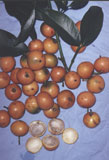 Madronos are one of our most interesting looking trees; they have deep green, shiny, leathery pairs of leaves that flush a spectacular fiery reddish bronze. The lateral branches are opposite, symmetrical and widely angled giving a beautiful conical form to this stunning majestic tree. Native to the wet forests of and Southern Mexico the madrono is a slow growing tree that will reach a mature height of about six meters. Because of this growth habit, the madrono makes an ideal potted specimen. It will look stunning for years before outgrowing a large container. Frost will damage the madrono but it is surprisingly tolerant of salt and varying soil conditions, it will however benefit from liquid fertilizer and of course plenty of mulch, they do not perform well in acid soils so a dressing of lime will also benefit in these conditions. Madronos fruit in the warmer months and are delicious picked and eaten when fully ripe; they also make an excellent jam. If they are picked unripe they are very acid and do not ripen off the tree. Related to the well-known mangosteen the madrono should be more widely planted not only for its tasty fruits but also as an unusual and striking ornamental specimen tree.
Madronos are one of our most interesting looking trees; they have deep green, shiny, leathery pairs of leaves that flush a spectacular fiery reddish bronze. The lateral branches are opposite, symmetrical and widely angled giving a beautiful conical form to this stunning majestic tree. Native to the wet forests of and Southern Mexico the madrono is a slow growing tree that will reach a mature height of about six meters. Because of this growth habit, the madrono makes an ideal potted specimen. It will look stunning for years before outgrowing a large container. Frost will damage the madrono but it is surprisingly tolerant of salt and varying soil conditions, it will however benefit from liquid fertilizer and of course plenty of mulch, they do not perform well in acid soils so a dressing of lime will also benefit in these conditions. Madronos fruit in the warmer months and are delicious picked and eaten when fully ripe; they also make an excellent jam. If they are picked unripe they are very acid and do not ripen off the tree. Related to the well-known mangosteen the madrono should be more widely planted not only for its tasty fruits but also as an unusual and striking ornamental specimen tree.
Rainforest tree of the month
White Booyong – Argyrodendron trifoliatum
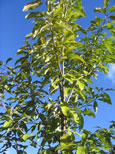 The white booyong is a lovely tree. It has very distinct foliage that makes it one of the easier rainforest trees to identify. It has trifoliolate leaves that have a very metallic sheen on the reverse; they are a bronze, silver colour that shines due to tiny scales on the backs of the leaves. This species is a secondary canopy species in the rainforest and is seen in the low light of the rainforest as a large stately buttress. It is capable of reaching 40 meters tall in the rainforest but in cultivation, it is much smaller, more commonly 15 – 20 meters with a spread of about 10m. The beautiful foliage make it an ideal choice as a container plant when young, however in time it will outgrow its container. Larger trees make excellent hosts for orchids and epiphytic ferns.
The white booyong is a lovely tree. It has very distinct foliage that makes it one of the easier rainforest trees to identify. It has trifoliolate leaves that have a very metallic sheen on the reverse; they are a bronze, silver colour that shines due to tiny scales on the backs of the leaves. This species is a secondary canopy species in the rainforest and is seen in the low light of the rainforest as a large stately buttress. It is capable of reaching 40 meters tall in the rainforest but in cultivation, it is much smaller, more commonly 15 – 20 meters with a spread of about 10m. The beautiful foliage make it an ideal choice as a container plant when young, however in time it will outgrow its container. Larger trees make excellent hosts for orchids and epiphytic ferns.
Book Review
I have been coming across many publications that I want to tell everyone about so I have decided to do some reviews in the next few newsletters. This month I want to talk about a small local publication compiled by the Far North Coast group of the Australian Plants Society called Sub-Tropical Australian Native Gardens. Contact secretary Denis Mathews, denmatth@bigpond.net.au for supplies. At only $10, it is a steal as it is full of wonderful information about our local species and information relevant to all types of gardening.
There is an excellent section on soils, how to improve them and the major problems associated with different types of soils. This little booklet contains my favourite soil test, the most simple and most important if you are planning any kind of orchard or tree plantation.
It has fantastic information on what not to plant near building or power lines; this is a question that is frequently asked. Did you know that a thirsty tree during a dry spell would seek water from as far away as twice its mature height.
There are excellent spreadsheets filled with information on rainforest trees, seaside plantings and popular native plants for home gardens. They include information on plants to attracts birds, butterflies, the colour of the flower, if the flower is perfumed and propagation methods as well as the usual information , including growth habit, exposure, flowering and fruiting season, suitability for growing in tubs and capability of coping with heavy soils.
There is an inspiring chapter on attracting birds and butterflies to your gardens, including how to deter goannas, currawongs, cats and foxes from attacking the nests of smaller birds. It also contains information on nectar plants for butterflies as well as the food plants for the caterpillars. Ferns, palms and orchids also get a chapter each with recommended plants suitable for anyone’s garden.
In short, if you are interested in gardening with natives this is an excellent addition to your library.





